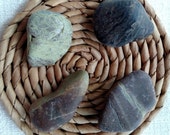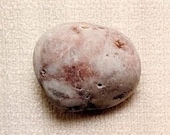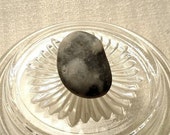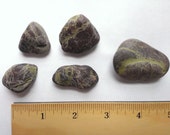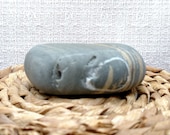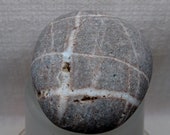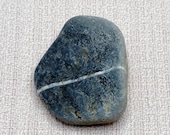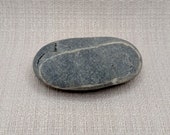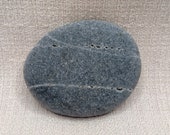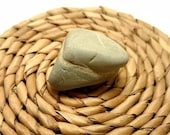Unearth the Beauty: Common Beach Stones of the Northeastern Coast
Nestled along the enchanting shores of the northeastern coast lies a world of natural treasures, each one a unique testament to the Earth’s geological artistry. These humble stones, shaped by millennia of waves, winds, and tides, hold stories of time and transformation within their grains. From the rugged landscapes of Maine to the serene stretches of sand on Cape Cod, the northeastern coast is a beachcomber’s paradise, offering a rich tapestry of beach stones just waiting to be discovered.
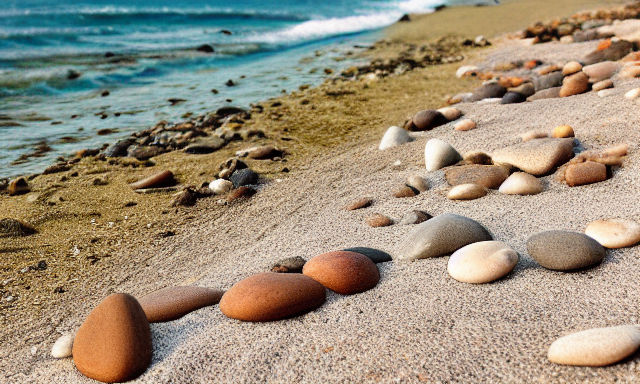
In this exploration, we delve deep into the remarkable diversity of common beach stones found in this region. With each step along the coast, you embark on a journey through geological history and natural artistry. We’ll guide you through the mosaic of colors and patterns etched into the stones, and we’ll uncover the secrets they hold about the Earth’s ancient past.
Join us on a captivating voyage of discovery as we unveil the beauty, history, and significance of these common beach stones. Whether you’re a seasoned beachcomber or simply someone who loves the allure of the shore, this journey promises to enrich your understanding of the captivating world of northeastern coastal geology.
| Rock Type | Description |
|---|---|
| Quartzite Stones | These stones often have a glassy appearance, and they come in various colors, including clear, white, pink, and gray. |
| Granite Stones | Granite is a prevalent rock type in the region, and you’ll find a variety of granite beach stones in different colors like gray, pink, and speckled with black. |
| Basalt Stones | Basalt is a dark-colored rock, and basalt beach stones can vary from dark gray to black. They often have a smooth and fine-grained texture. |
| Schist Stones | These stones can be greenish-gray and may have a layered appearance. They are known for their foliation and unique textures. |
| Gneiss Stones | Gneiss beach stones can be quite colorful, with banding patterns that include grays, pinks, and even blues. |
| Marble Stones | You might find marble beach stones in various colors, but they’re often recognized by their smooth, polished appearance. |
| Slate Stones | Slate beach stones can be dark gray, and they’re often thin and flat, with a layered structure. |
| Limestone Stones | Limestone beach stones are lighter in color, ranging from light gray to tan. They may contain visible fossils. |
| Sandstone Stones | These stones often have a grainy appearance and can be found in various shades of red, brown, or gray. |
| Mica Schist Stones | These stones contain mica minerals, which can give them a shimmering appearance. |
| Metamorphic Rocks | Many beach stones in the northeast are metamorphic rocks, which have undergone significant changes due to heat and pressure. They often have unique patterns and textures. |
| Igneous Rocks | Igneous rocks like diorite, rhyolite, and andesite can also be found along the coast. |
| Seashell Fossils | In some areas, you might come across stones with embedded seashell fossils, providing a glimpse into the region’s geological history. |
| Flint | Flint stones are known for their hardness and conchoidal fracture, often appearing dark gray to black. |
| Quartz Stones | Clear quartz and other varieties of quartz stones can be found, often recognized by their translucent appearance. |
| Agates | While less common, agates with their banded and often colorful patterns are prized finds. |
Geological Background
The northeastern coast, with its stunning seascapes and pristine beaches, is a geological wonderland. To understand the beach stones that grace these shores, we must first embark on a brief journey through geological history.
Formation of the Northeastern Coast
The geological story of the northeastern coast began eons ago when the Earth’s crust underwent a series of dramatic shifts. During the last ice age, massive glaciers covered the land, sculpting the terrain and depositing vast amounts of sediment and stones. As the ice eventually receded, it left behind an intricate mosaic of geological features, including the sandy shores and rocky outcrops we see today.
The Role of Glacial Till
One of the key factors that contributed to the formation of beach stones in this region is glacial till. This is the mix of clay, silt, sand, and gravel that glaciers carry and deposit as they move. Glacial till often contains a wide assortment of rocks of different sizes, shapes, and origins. When the glaciers retreated, they left behind this mix of material, which became the foundation of the northeastern coast’s geological diversity.
Beach Stone Formation
The beach stones we find today are primarily sedimentary and metamorphic rocks, although igneous rocks can also be present. These stones are often the result of the compaction and cementation of sediments over vast spans of time. Sandstone, shale, and limestone are common sedimentary rocks that have been shaped by the pressures and temperatures of the Earth’s crust. Metamorphic rocks like schist and slate have transformed from their original state due to heat and pressure. All of these rocks can be found scattered along the coastline, bearing the marks of their unique histories.
Coastal Beach Stones
As you stroll along the northeastern coast, you’ll encounter a mesmerizing array of beach stones, each telling a distinct geological tale. From smooth and polished pebbles to rugged and jagged rocks, the stones you discover have been molded by the patient craftsmanship of Mother Nature. In the sections that follow, we’ll introduce you to some of the most common varieties found on these captivating shores.
Common Beach Stones of the Northeastern Coast
Pebbles and Cobblestones
As you wander along the northeastern coast, the first thing you’re likely to notice are the pebbles and cobblestones that make up the beach. These smooth, rounded stones are the result of countless years of tumbling in the waves. Some are as tiny as a grain of sand, while others are substantial enough to fill your hand.
Pebbles often come in a variety of colors, predominantly shades of gray, brown, and white. They can be composed of different rock types, such as granite, basalt, or quartz, and might exhibit unique patterns and textures.
Cobblestones are larger cousins of pebbles and can range from golf ball-sized to several inches in diameter. They, too, display diverse colors and patterns, which depend on the rock type they originated from. Cobblestones add a distinctive charm to the coastal landscape, forming picturesque patterns along the water’s edge.
Schist and Slate
Two common metamorphic rocks found on the northeastern coast are schist and slate. These rocks often split into thin, flat layers, making them stand out on the shore. Schist is recognized for its foliated structure, creating layers that glitter when they catch the sunlight. Slate is often dark gray, smooth to the touch, and easy to break into thin sheets. Both of these rocks are a testament to the geological history of the region.
Sandstone and Shale
Sandstone and shale, two sedimentary rocks, also grace the coastlines of the northeast. Sandstone is composed of sand-sized grains cemented together, while shale is formed from clay and silt-sized particles. These rocks have a knack for preserving imprints of ancient life in the form of fossils, which are occasionally visible on their surfaces.
Granite
Granite is another noteworthy rock type you’ll encounter along the northeastern coast. Known for its coarse-grained texture and salt-and-pepper appearance, granite forms as molten rock (magma) slowly cools below the Earth’s surface. Over time, the cooling process allows large mineral crystals to develop, giving granite its distinctive speckled look. Beach stones made of granite may be rough or polished, depending on their history.
Igneous Intrigues
Igneous rocks, born from the cooling and solidification of molten material, add intrigue to the coastal collection. While less common than sedimentary or metamorphic stones, igneous rocks like basalt and rhyolite can be discovered here. Basalt is dark and often appears as columnar structures along the cliffs or in the form of beach stones. Rhyolite, on the other hand, is light in color and frequently found in volcanic regions of the northeast.
Each of these stones plays a role in the geological tale of the northeastern coast, their unique characteristics reflecting the region’s rich history. As you explore the shores, keep an eye out for these common beach stones, and take a moment to appreciate the stories they silently tell.
Wishing Rocks
The Art of Beach Stone Identification
The Visual Clues
Identifying beach stones along the northeastern coast can be both rewarding and educational. A close examination of a stone’s physical attributes provides valuable insights into its origin. Here are some visual cues to help you identify common beach stones:
Color: The color of a stone can offer significant clues. Granite, for instance, often appears mottled in shades of gray, black, and white. Slate is typically dark gray, while sandstone exhibits a warm, sandy color.
Texture: Run your fingers along the stone’s surface. Is it smooth or rough? Many beach stones become polished over time by the action of waves and wind. Sandstone is often remarkably smooth, while schist is foliated, creating a ridged texture. Granite is usually coarse-grained, and cobblestones are smooth due to their extended exposure to wave action.
Patterns: Keep an eye out for distinctive patterns, as some stones, like granite, display characteristic speckles. Schist, with its layers, can often catch the light in a way that sets it apart from other rocks.
Shape: The shape of a stone can also be an indicator of its origin. Cobblestones are typically well-rounded and oval, while shale can be found in flat, layered pieces. Basalt often appears as angular columns, and sandstone can display a soft, rounded form.
The Sound Test
Another simple but effective method for identifying beach stones is the sound test. Gently strike the stone against a hard surface or another stone. The sound it produces can reveal clues about its composition. For instance, a high-pitched, metallic sound often suggests a high quartz content, which is common in many beach stones.
Density and Weight
The weight of a stone can hint at its density and composition. Beach stones made of dense materials like granite or basalt will feel heavier in your hand than lighter stones like pumice, which is filled with air bubbles and often found washed up on shores.
Streak Test
The streak test involves scratching a stone on a piece of unglazed porcelain, much like you would with a streak plate when testing minerals. The streak left on the porcelain can help identify the stone’s mineral content. However, this test is less commonly used with beach stones and is more typical for mineral identification.
Consult Local Resources
Local guidebooks, websites, or geology clubs can be invaluable resources for identifying beach stones along the northeastern coast. These sources often provide information about the geological history of the area, the types of rocks commonly found, and photographs for reference.
Keeping a Beach Stone Journal
To enhance your skills in beach stone identification, consider keeping a journal where you record your findings. Describe the stone’s color, texture, patterns, and any distinctive features. Include the date and location where you found it. Over time, your journal can become a valuable reference for your beachcombing adventures.
As you immerse yourself in the art of beach stone identification, you’ll develop a deeper appreciation for the diverse geological tapestry that lines the shores of the northeastern coast. Each stone you identify becomes a window into the Earth’s history, offering a unique glimpse into the processes that have shaped our planet.
The Fascinating World of Northeastern Beach Stones
Granite: The Coastal Workhorse
Granite is one of the most common and recognizable stones found on the northeastern coast. It’s known for its distinctive speckled appearance, created by the interlocking crystals of various minerals. Granite comes in shades of gray, black, white, and even pink, and its durability makes it ideal for building materials. If you discover a stone with a coarse texture and an array of speckles, you’re likely holding a piece of granite that once formed part of a mountain.
Sandstone: The Weathered Wonder
Smooth, rounded sandstone is a frequent sight along the northeastern shores. This stone, created through the accumulation and cementation of sand grains, is often a pale yellow, tan, or light gray. Its texture is remarkably soft and polished due to its long exposure to the elements. Sandstone embodies the slow passage of time and can carry the echoes of ancient landscapes in each grain.
Basalt: The Dark and Durable
Basalt, characterized by its angular columns and deep gray to black hue, is another prevalent beach stone. These columns result from the rapid cooling and solidification of lava flows. Basalt stones often have a distinctly geometric look, like a mosaic of hexagonal shapes. They are tough and resistant to weathering, making them a resilient presence along the coast.
Schist: Layers of History
Schist is known for its foliated structure, formed from the layering of minerals under heat and pressure. This rock can be gray, green, or brown and often sparkles when light catches its surface. Schist’s layered appearance is a testament to the earth’s geological processes, where ancient sediments transformed into rock over millions of years.
Slate: A Fine-Grained Beauty
Slate is a fine-grained metamorphic rock that often appears dark gray or black. It splits easily into thin sheets, a quality that made it valuable for roofing material in the past. These thin sheets can be stacked to form a structure or used in garden pathways. Beachcombers are drawn to slate for its sleek, minimalist appearance.
Pumice: The Lightweight Wonder
Unlike the dense stones often found on the northeastern coast, pumice is an exception. This light and airy volcanic rock forms when frothy lava cools rapidly, trapping gas bubbles within. Pumice stones are incredibly lightweight and often float in water. Their porous texture is a distinctive characteristic, making them an intriguing find among the denser rocks.
Rounded Pebbles: Treasures of the Tide
Smooth, rounded pebbles are among the most prized finds on the northeastern shore. These stones owe their polished appearance to years of tumbling in the waves. They come in an array of colors, from soft pastels to vibrant reds, blues, and greens. The unique blend of minerals in each pebble results in their striking appearances.
Unique Gems and Fossils
Occasionally, you may discover gems, fossils, or unusual formations among the more common beach stones. Crystals, agates, and fossils provide exciting surprises for beachcombers. These unique specimens offer a glimpse into the earth’s history and the forces that have shaped it.
Where Geology and Artistry Meet
The northeastern coast offers a perfect blend of geology and artistry. Each stone is a testament to the earth’s history, the relentless sculpting of waves, and the artistry of nature. As you explore the beaches of this region, you’ll find yourself not only identifying stones but also unraveling the stories of our planet, etched in every pattern and texture.
Metamorphic and Igneous Rocks: The Unveiling of Geological Stories
The Transformative Power of Metamorphic Rocks
The northeastern coast is a realm where the enduring metamorphic rocks tell remarkable tales of transformation. These rocks originated from sedimentary or other metamorphic rocks that underwent profound changes under heat and pressure deep within the earth. Let’s explore a few of these fascinating specimens:
Marble: The Elegance of Metamorphism
Marble is the epitome of metamorphic elegance. This rock began as limestone but was subjected to intense heat and pressure, which recrystallized its minerals and changed its structure. The result is a smooth, often white or cream-colored stone with intricate veining. Marbled surfaces were favored by sculptors throughout history, showcasing the timeless beauty of metamorphic rock.
Slate: Nature’s Blackboard
Slate is another metamorphic treasure found along the northeastern coast. This fine-grained rock, often dark gray to black, cleaves into thin sheets due to the alignment of its minerals during metamorphism. Slate’s exceptional property of easily splitting into thin layers has made it invaluable for everything from roofing material to artistic creations.
Phyllite: The Shimmering Schist
Phyllite is a close cousin of schist and shares the foliated appearance but tends to have a shinier sheen. This unique quality is due to the alignment of its minerals during metamorphism. Often displaying shades of gray, green, or brown, phyllite adds an element of shimmer to the rocky narratives along the coast.
Schist: Layers of Time
As previously mentioned, schist is a metamorphic rock known for its foliated structure. The layering of minerals formed during metamorphism gives schist its distinctive texture and often results in sparkling surfaces when light hits its layers. This rock offers a glimpse into the dynamic geological history of the region.
The Endurance of Igneous Rocks
While metamorphic rocks speak of transformation, igneous rocks along the northeastern coast narrate tales of fiery origins and enduring strength. These rocks form from the solidification of molten magma and vary in appearance, composition, and texture:
Basalt: The Dark and Resilient
Basalt, a common igneous rock, often presents itself as dark gray to black columns with a hexagonal shape. These distinctive columns are the result of the rapid cooling and solidification of lava flows. Basalt’s resistance to weathering is a testament to its durability and endurance in the face of the relentless coastal elements.
Granite: The Iconic Intruder
Granite, an igneous rock, intrudes upon the scene with its coarse texture and recognizable speckled appearance. The speckles arise from the interlocking crystals of various minerals within the rock. You’ll often find granite rocks in shades of gray, black, white, or even pink.
Pumice: The Lightweight Gem
Pumice is an intriguing igneous rock due to its remarkable lightweight properties. Formed from frothy lava that cools rapidly, pumice is filled with tiny gas bubbles. This creates its porous texture, and these stones often float in water. While not as dense as some other rocks, pumice remains a captivating find along the northeastern coast.
As you explore the beaches of the northeastern coast, keep an eye out for these metamorphic and igneous rocks. Each one tells a unique geological story and contributes to the rich tapestry of the region’s geological history.
The Storytellers of Time: Sedimentary Rocks
The Coastal Chronicles Etched in Sandstone
Sedimentary rocks hold a special place along the northeastern coast, as they are the storytellers of time. These rocks form from the accumulation and compression of sediments over millions of years. They capture the history of ancient seas, rivers, and environments. Here are a few key players in this geological narrative:
Sandstone: Whispers of Ancient Shores
Sandstone, with its grainy texture, speaks of ancient shorelines and riverbeds. These rocks, composed of sand-sized mineral, rock, or organic particles, often bear cross-bedding structures. These structures reveal the direction of ancient currents and create captivating patterns on the coastal cliffs and shores.
Shale: Layers of Seabed Secrets
Shale is another sedimentary rock that unfolds stories of the seabed. It’s characterized by its fissile nature, which means it splits into thin layers. Shale’s layers can contain fossils of ancient marine life, providing insights into the creatures that once inhabited the waters that covered this region.
Limestone: Echoes of Coral Reefs
Limestone, often associated with ancient coral reefs, is abundant along the northeastern coast. This rock forms from the accumulation of the calcite shells and skeletons of marine organisms. The presence of limestone can hint at the bygone existence of vibrant coral ecosystems beneath the waves.
Conglomerate: The Remnants of Powerful Flows
Conglomerate is a fascinating sedimentary rock that tells tales of powerful water flows. These rocks are composed of rounded pebbles, cobbles, and boulders embedded in a matrix. Their presence suggests tumultuous river channels and alluvial fans that once existed in the region.
The Dynamic Interplay
Sedimentary rocks play a vital role in shaping the coastal landscapes. Erosion, tides, and geological forces continuously work together to reveal these ancient layers, creating the stunning cliffs, sea stacks, and shorelines that define the northeastern coast.
As you walk along the beach, pause to admire the intricate layers and patterns within sedimentary rocks. Each rock is a page in the geological history of this captivating region.
Metamorphic and Igneous Rocks
The northeastern coast of the United States is characterized by a fascinating geological diversity. In addition to the sedimentary rocks discussed earlier, the region also features prominent metamorphic and igneous rocks. These rocks have undergone significant transformations due to intense heat and pressure, or in the case of igneous rocks, originated from molten material. Here, we explore the concept of metamorphic and igneous rocks in the region and highlight examples of each.
Metamorphic Rocks
Schist: Schist is a common metamorphic rock along the northeastern coast. It exhibits a foliated structure, characterized by its layered appearance. Schist is formed from pre-existing rocks, like shale or granite, which have undergone metamorphism. The heat and pressure cause the minerals within these rocks to recrystallize, creating the distinctive layers seen in schist.
Slate: Slate is another metamorphic rock found in this region. It’s known for its fine-grained texture and ability to split into thin sheets, which makes it highly valued for roofing and architectural purposes. Slate often forms from shale through metamorphic processes, giving it its signature characteristics.
Quartzite: Quartzite is a metamorphic rock that originates from sandstone. Under immense heat and pressure, the grains of sandstone recrystallize into a much harder and more durable rock. This natural stone is often used for countertops and tiles due to its strength and unique patterns.
Gneiss: Gneiss is a banded metamorphic rock that results from the transformation of either granite or shale. It’s known for its alternating light and dark mineral bands, and this appearance is created by the intense heat and pressure it undergoes. Along the northeastern coast, you can encounter formations of gneiss.
Igneous Rocks
Granite: Granite is a prevalent igneous rock in the northeastern coastal region. It’s known for its coarse-grained texture and is composed of various minerals such as feldspar, quartz, and mica. Coastal landscapes, especially in Maine, are dotted with stunning granite outcrops, many of which have been shaped and smoothed by the sea’s relentless actions.
Basalt: Basalt is an igneous rock that forms from solidified lava. It typically appears dark and dense with fine grains. In coastal regions with a history of volcanic activity, such as parts of coastal New England, you can find basalt formations.
These metamorphic and igneous rocks contribute to the geological richness of the northeastern coast. They bear the marks of incredible geological processes and transformations that have taken place over millions of years. While igneous rocks like granite offer durability and utility, metamorphic rocks like schist and slate display the intricate patterns and foliations created during their formation.
Balancing Rocks – Cairns
Rocks of the Northeastern Coast
A Geological Treasure Trove
The northeastern coast, with its rich geological history, offers a treasure trove of rock types. Here’s an exploration of some of the most prominent rock types commonly found in the region:
1. Granite (Igneous):
Granite, a beautiful and enduring rock, is one of the primary igneous rocks in the northeastern coastal region. It’s often recognized by its coarse-grained texture, composed of various minerals like feldspar, quartz, and mica. Coastal landscapes, including Maine, are known for their stunning granite outcrops, many of which have been shaped and smoothed by the relentless action of the sea.
2. Schist (Metamorphic):
Schist, a metamorphic rock, is characterized by its foliated structure. It often displays layers of minerals that have been subjected to immense heat and pressure over time. The northeastern coast is home to some schist-rich areas, offering remarkable geological features.
3. Slate (Metamorphic):
Slate, another metamorphic rock, is celebrated for its fine-grained texture and tendency to split into thin sheets. This characteristic makes it valuable for roofing and architectural purposes. Along the coast, you can find regions with abundant slate deposits, showcasing its versatility.
4. Quartzite (Metamorphic):
Quartzite is a metamorphic rock formed from sandstone. It’s exceptionally hard and durable, making it a prominent choice for countertops and tiles. In the northeastern coastal region, you can discover outcrops of quartzite with unique coloration and patterns.
5. Basalt (Igneous):
Basalt, an igneous rock, is formed from solidified lava. It often presents as dark and dense, with fine grains. Coastal areas with volcanic history, such as parts of coastal New England, may exhibit basalt formations.
6. Gneiss (Metamorphic):
Gneiss, a metamorphic rock, displays alternating bands of light and dark minerals. It results from the metamorphism of either granite or shale. In certain sections of the northeastern coast, you can encounter gneiss formations.
7. Sandstone (Sedimentary):
While igneous and metamorphic rocks dominate the region, some coastal sections contain sandstone formations. These sedimentary rocks often exhibit cross-bedding and are significant in understanding the geological history of the area.
Geological Footprints
The northeastern coast’s geological tapestry tells a story of immense natural forces and ancient processes. Granite, the state rock of Maine, is renowned for its durability and its widespread use in construction, including lighthouses, bridges, and cobblestone streets. The schist-rich areas offer a unique glimpse into the region’s metamorphic history, with foliated patterns and intriguing mineral compositions.
Slate and quartzite, also present in the area, bear witness to the diverse geological processes that have shaped the coast over millions of years. Basalt formations provide evidence of ancient volcanic activity, adding another layer to the geological narrative. Gneiss, with its banded appearance, reflects the intricate transformation of rock under heat and pressure.
As you explore the coast and its rocks, you’re not merely admiring scenic views but also traversing through Earth’s geological history. It’s a journey through time, where the land’s memory is etched in stone.
Coastal Ecosystems: Nature’s Canvas
A Symphony of Adaptations
The northeastern coast is a testament to the remarkable adaptations of its flora and fauna. The combination of harsh coastal conditions, such as salt spray, fluctuating temperatures, and high winds, has led to the development of resilient ecosystems. Here are some of the fascinating elements that make up this coastal canvas:
Coastal Flora
Seaside Goldenrod (Solidago sempervirens): With its brilliant yellow blossoms, seaside goldenrod thrives along the coast. Its vibrant blooms provide essential late-season nectar for pollinators.
Beachgrass (Ammophila breviligulata): Beachgrass plays a critical role in stabilizing sand dunes. Its deep roots anchor the dunes and prevent erosion.
Rose Hips (Rosa rugosa): Rosa rugosa, or beach rose, adorns the coastal landscape with its fragrant pink or white flowers. Its red rose hips are a valuable food source for wildlife.
Coastal Fauna
Piping Plover (Charadrius melodus): This small shorebird is an endangered species and nests directly on the beach. Conservation efforts are in place to protect its fragile habitats.
Atlantic Horseshoe Crab (Limulus polyphemus): Horseshoe crabs are ancient marine arthropods that play a crucial role in the ecosystem. Their eggs are a vital food source for migratory shorebirds.
Common Tern (Sterna hirundo): These graceful birds can be spotted swooping over the coast, diving for fish. They nest in colonies on islands and coastal sites.
The Dance of Predators and Prey
The coastal ecosystems create a dance of predators and prey. Seals, such as gray and harbor seals, are often seen along the shores, particularly in winter. These marine mammals have made a remarkable recovery in recent years. Their presence is a testament to the improvement of water quality and the restoration of the coastal ecosystem.
Birds, including osprey, herons, and gulls, are part of the coastal skies. Osprey, in particular, are a charismatic species known for their remarkable hunting skills.
Conservation Efforts
The northeastern coastal region is not only a rich tapestry of life but also a delicate one. Conservation efforts are in place to protect these unique ecosystems and the species that call them home. Organizations work to safeguard nesting shorebirds, manage the balance between human activity and wildlife habitat, and restore critical dunes and marshes.
Visiting these coastal areas provides an opportunity to observe the delicate interplay of nature and appreciate the efforts to ensure its preservation. Remember, while exploring these ecosystems, it’s essential to tread lightly, leaving only footprints, taking only photographs, and fostering a deep respect for this natural wonderland.

